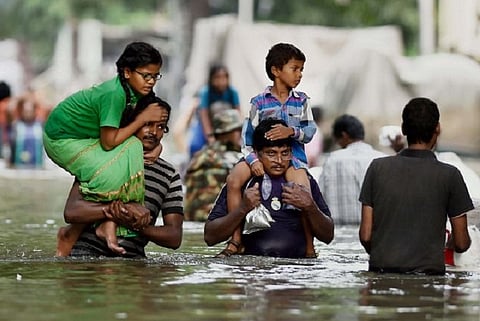

Scores dead, hundreds left homeless as flood waters swept through Chennai and its suburbs, leaving behind a trail of destruction. Now two-and-a-half years later, the Comptroller and Auditor General of India (CAG) has minced no words in calling the Chennai Floods of 2015, a “manmade disaster”, pinning the blame on the Tamil Nadu government for its handling of the crisis.
The CAG report titled ‘Flood management and response in Chennai and its suburban areas’, was tabled in the Tamil Nadu Assembly on Monday.
In the aftermath of the disaster, several reports highlighted how failure to ensure timely release of water from the Chembarambakkam Lake in Chennai during the Northeast monsoon season had resulted in the floods. The CAG report puts a spotlight on just how Chembarambakkam Lake sank Chennai, pointing to glaring errors such as “imprudent and injudicious release of water”, absence of scientific real-time flood forecasting and communication facilities, and lack of monitoring in release of water at the reservoir.
‘Emergency should have been declared on November 16, 2015’
One of the biggest findings of the CAG report was that the Water Resources Department had failed to revise the Compendium of Rules and Regulations (COR) for Chembarambakkam Lake in 23 years. The Central Water Commission norms on Dam Safety mandated that a COR be issued that puts in place an emergency action plan.
With a capacity to store 3.645 TMC of water and at a storage depth of 24 feet, Chembarambakkam Lake is one of the two reservoirs supplying water to Chennai city. While Poondi – the city’s other reservoir – had a COR in place, Chembarambakkam had not revised its COR since 1993.
The CAG notes that if the COR of Poondi Reservoir were to be applied for Chembarambakkam, “Extraordinary Emergency should have been declared when the depth of water reached 21 feet (It reached 21 feet on 16/11/2015 12 noon) and the water was maintained above that level till 02/12/2015)."
But what in fact did happen is that extraordinary emergency was not declared. The district Collector and police officials were informed on December 1, 2015 when the depth of water in Chembarambakkam was 22.5 feet.”
‘Magnitude of flooding could have been reduced’
The CAG emphasises that compendium of rules and regulations were violated by the Water Resources Department (WRD). The report states, “As per the COR for Regulated Tanks, WRD should store water at the Full Reservoir Level in the month of December, as the monsoon starts receding. The COR also does not allow presence of private patta land inside water spread area. As such, the patta land was required to be acquired for ensuring storage of water till the full capacity of the reservoir.”
It, however, found that the Chembarambakkam Lake had not reached full capacity during the 2015 monsoon, and that even on the days of maximum inflow – December 1, and December 2 – water was stored only upto a maximum of 3.481 TMC, leaving 0.164 TMC of remaining capacity unutilised.
The CAG states that officials at the Water Resources Department did not maintain Full Reservoir Level to avoid possible submergence of the patta land on foreshore area. While the Tamil Nadu government claimed that it had failed to acquire the patta land considering the costs, the CAG goes on to observe that had it done so, “the storage capacity could have been maintained to its fullest and magnitude of flooding could have been reduced as more water could have been stored in the reservoir.”
‘Manmade catastrophe for which TN govt was responsible’
Another grave lapse was that the release of water from Chembarambakkam was not gradual, finds CAG. On December 1, 2015, the discharge of water was increased abruptly from 12,000 cusec to 20,960 cusec. The report states, “This was a serious failure in operation of the reservoir, thus, contributing to the massive disaster. Such imprudent and injudicious action by the Tank-in-charge as well as WRD warrants detailed enquiry.”
The continuous discharge of water at 29,000 cusec for 21 hours resulted in a huge flow of flood water in the downstream Adyar River. The CAG stressed that indiscriminate increase in the discharge of water from Chembarambakkam together with the fact that Chennai Corporation officials had failed to take up desilting work and other flood protection measures in the Adyar River “had proved that the disaster that had happened in November-December 2015 was not a natural disaster but was indeed a manmade catastrophe as per CWC norms, for which GoTN was responsible.”
The CAG report also goes on to point out that the Water Resources Department did not have real-time forecast and scientific assessment of inflow as prescribed by CWC guidelines. Moreover, it also found that the wireless communication at Chembarambakkam had not been functioning for more than six months before the December 2015 floods.
While the Tamil Nadu government had in its March 2017 reply to CAG stated that the release of water was based on the existing Compendium of Rules and Regulations and revision of Compendium and formulation of Emergency Action Plan were under progress, the CAG found its reply not tenable.
“The reply was not tenable as WRD failed to revise the Compendium even after a lapse of 23 years from the date of installation of regulated arrangement to the tank and no lessons were learnt from the damages caused to life and property in the floods of 2005,” stated CAG.
In light of its findings, the CAG recommends “immediate updation of the Compendium of Rules and Regulations of Chembarambakkam Tank and fixing responsibility on officials for their failure to follow CWC’s guidelines on Dam safety.”